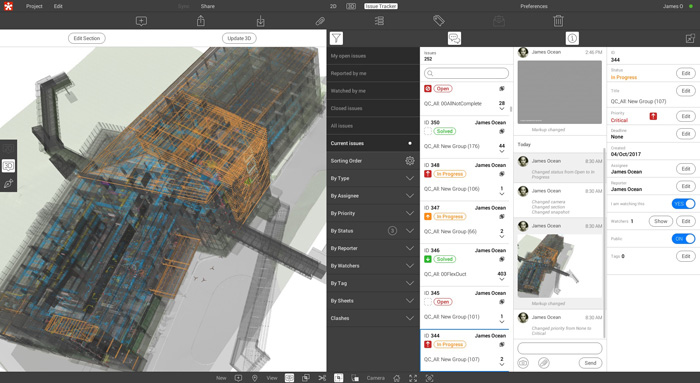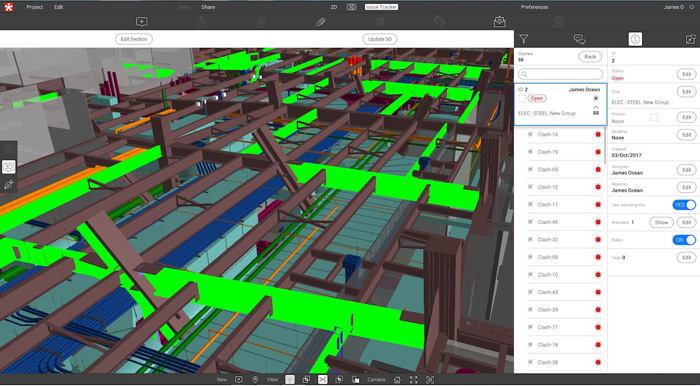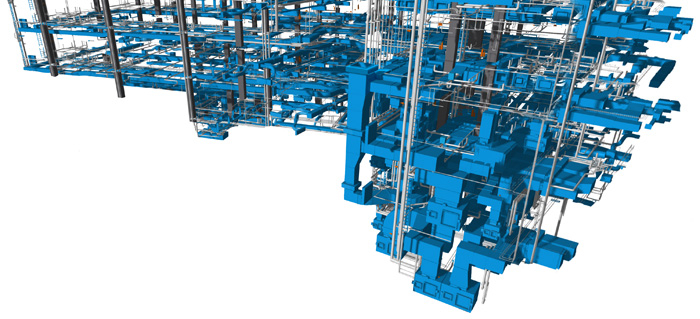AEC Magazine speaks with Revizto’s Rhys Lewis to find out more about the simple-to-use cloud-based collaboration tool that can work with 2D and 3D data
Q: Can you give us a quick overview of Revizto – what the software is used for and the types of firms that use it?
A: Revizto is a centralised cloud-based communication, collaboration and coordination technology designed specifically for engineering and construction projects. Our focus is on tracking, recording and producing data for all the issues facing our clients. A ‘Single Source of Truth’ in a word giving the whole project team confidence and transparency.
Revizto today is being used by over 90,000 global unique users including organisations such as: AECOM, Arup, Foster & Partners, VINCI, Willmott Dixon, Lend Lease, BOSCH, Siemens and many others.
Q: What size projects is Revizto typically used on?
A: Projects of all sizes from small law offices to stadiums, airports, infrastructure and everything in between.
Q: Issue tracking is at the heart of the software. Can you explain the process from the creation of issues to their approval?
A: This process begins when an issue is found in a 3D, 2D, Clash Detection Test or a VR walkthrough environment in any discipline.
Once the issue is generated everything about that issue it tracked, and users can easily assign responsibility, deadlines, priority and communicate specifically on the issue in a real time environment. The status of the issue is tracked as it moves from an Open Status to In Progress all the way to Solved, where it then can be closed by the proper QAQC team members.

Q: How are users notified about issues and changes in status? Through email notifications?
A: Users are notified through in-application notifications. They will also receive an email notification if offline when an issue is assigned to them or if an issue concerning them is updated. I tend to fine tune these so that I get one email, per project, per day with all activity concerning me in a PDF report.
Q: Revizto uses the cloud to support distributed teams. We all know BIM models can be huge so how does Revizto handle the flow of this data? Do teams have to upload entire BIM models every time or does it work with deltas as projects progress?
A: All of our communication works in real time. When handling the models we can set up automated exports or we can push the model manually based on user input. The way Revizto works is through a local cache that allows the users to take advantage of local hardware and the ability to work offline. This cache then synchronises with the model in the cloud. We have the ability to push data to Revizto from a wide range authoring and coordination tools as well as the ability to work with open source data such as IFC.
Q: Revizto works with a number of different AEC software tools, including Revit, Navisworks, Civil 3D, SketchUp and ArchiCAD – some through plug-ins and others through neutral formats. Your website states that once data has been brought in, all BIM object data and linked files are preserved. Can you explain this in more detail?
A: What Revizto does is very unique, and in many ways just moves your model and all of the properties of the BIM model into an environment specifically designed for project review and communication.
Unlike PDF collaboration software on the market, Revizto keeps the 2D documentation connected to the 3D environment and allows the users to jump back and forth seamlessly as they create project review issues that are accessible in both the model and the documentation. Not only that but it allows you to centralise what was once two (or even more if you use VR) separate review processes.
Access to the BIM Properties and Clash Detection is also integrated into the environment as well, creating a wealth of project information in once place and easily accessible. Revizto is a very user-friendly tool that allows you to put a very technical model, into the hands of somebody not very technical at all, on a tablet.

Q: Does Revizto work better with applications that have native plug-ins over ones that rely on neutral formats like IFC? Also, are all plug-ins equal? One might imagine you can get more out of Revit, a true ‘BIM’ application, than a modelling tool like SketchUp.
A: Revizto is very good about working with both native plug-in data and open source BIM data. Revizto can read BIM properties from almost any source and the coordination aspect is based on coordinates rather than objects which allows seamless integration with many tools and file formats.
Q: For clash detection, Revizto relies on other applications such as Navisworks and Solibri. How does this work in practice?
A: These tools are focussed on clash detection and rely on disjointed communication methods which is where Revizto steps in.
In most successful implementations you will see the role of a Navisworks or a Solibri user reduced to creating federated models and generating clash tests. This information then will be brought into Revizto for the purpose of assigning responsibility, day to day communication and a much more organised approach to QAQC practices. Revizto would then contain not only the clash sets but also the rest of the issues which are most commonly created as 2D and 3D mark-ups then emailed as PDF. Revizto helps capture and digitalise all issues into a single, digital audit trail.
Q: Are there any plans to add clash detection to Revizto itself?
A: There have been discussions but there is more than a technical achievement to be had there. There are also some other business and relationship obstacles.
Q: Construction projects involve many different participants. How is your licensing set up to handle multiple firms?
A: Licensing is cloud based from our online hub and allows you to simply invite anyone with an email address to your project and consume a licence, if your collaborator is already a Revizto customer then they can be added to your licence as a guest but still consume a licence from their pool. Project participants can be removed and added easily making this a flexible way to make sure you are getting the most use from the licences you purchase.
Q: Revizto offers VR support through the Oculus Rift and HTC Vive. Do any markups get fed directly back into the BIM authoring tool?
A: Issues can be created in 2D or 3D wherever you have the plugin installed. All issues including clashes are then stored centrally within the issue tracker, your new digital audit trail. The Issue Tracker dynamically links back to the exact position of the issue in 2D/3D in your authoring software regardless of where it is created. The mark-up remains in the Issue Tracker and it’s intelligently linked back to your authoring software for you to make the necessary changes.

Q: How are issues marked up and resolved inside VR, without traditional desktop input devices?
A: Our most promising VR Review workflow actually is a two person team effort. One user in VR performing the walkthrough and one user monitoring their walkthrough via camera share and inputting the issues they find. In VR you can create a one person workflow but will require input from your keyboard and mouse to input issues.
Q: Have you looked into developing markup tools that can be used inside VR?
A: VR markup improvements and UI accessibility are within our roadmap. For now, you can do that using a keyboard and mouse in the same VR Session.
Q: Revizto is available for Windows, Mac OS X, iOS and Android tablets. What’s the difference between the different client tools and how do mobile devices handle huge models, both in terms of size and the demands on 3D graphics?
A: Revizto has a wide array of visibility quality settings and is a very lightweight model format. The application right now is the same version on every platform we offer and there are certain parts of the iOS versions that have built in optimisations for use on those platforms.
Q: So, does that mean the Revizto plug-ins (for Revit, SketchUp, ArchiCAD, etc.) talk directly to the Revizto cloud and don’t go via the Revizto client?
A: The authoring tools export to a local cache that then syncs with the Cloud.
Q: We’re currently seeing a lot of developments in the use of reality modelling for tracking construction progress and resolving issues on site. Are there any plans to support reality models inside Revizto, such as point clouds or reality meshes?
A: We actually can handle reality capture data as long as it is a mesh in .FBX format.
We are looking to expand on this in the future but have other development priorities based around 2D workflows at the moment. However if you can get your reality capture data into a mesh in .FBX format, Revizto can use it.
Q: It sounds like your users rely very heavily on 2D workflows. Could you expand on why 2D is still important and what challenges you are trying to solve with new developments?
A: Construction documents are the basis of how a project is actually constructed in the field and also currently hold the most legal viability. 2D is also the main communication language to the field and as the future for us is a fully integrated and cf;ommon design review environment we feel that implementing a product that is user friendly in the field and has the ability to tie the legal documents to the BIM model in a collaborative environment is the way of the future.
Q: Mixed Reality looks to be a great technology for tracking and resolving issues on site? Have you done any work with headsets like the Microsoft HoloLens?
A: The development team are always working closely with our customer base and listening to what they want, our development roadmap is quite customer driven. AR is something we are certainly investigating.
Q: What does the future hold for Revizto?
A: Our initial vision is to create an all-inclusive design review platform built around modern design and construction technology.
We want our clients to have the luxury of using less tools in this area but have familiar workflows but all the benefits of a BIM model with full properties, coordinated documents, and the ability to Track, Assign, Record and Report on all the problems they face in a project. That is our #1 goal.
That being said, our platform shows promise in many other areas as well such as Facility Management, Logistical Planning, Mechanical Engineering and Production. So once we nail down our short term goals in the AEC industry there are plenty of opportunities for us.
We’re very excited about the future!

If you enjoyed this article, subscribe to AEC Magazine for FREE






